
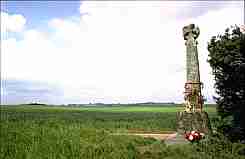
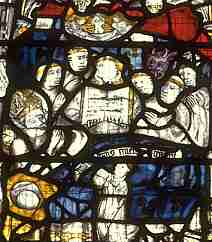
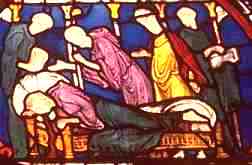
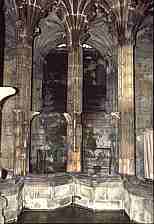
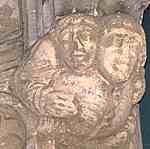
If you are looking at this page without frames, there is more information about medieval writing to be found by going to the home page (framed) or the site map (no frames).
| Herbals and Medical Texts (2) | |||||
| Many medical manuscripts are illustrated with miniatures depicting human anatomy, surgical procedures or diagrammatic representations of the location of certain ailments. The anatomical depictions are rarely accurate or precise, but it would be a mistake to assume that medieval doctors had an imprecise conception of human anatomy. The church did not ban the examination of corpses for the purpose of medical knowledge, although it did regulate the procedure. However, certain unpleasant facts about medieval life ensured that people had a much better idea of what went where than many of us do today. | |||||
 |
Medieval romance might have us believe that battles were places where chivalric knights on fine horses biffed each other around a bit, then when one fell off, the other politely helped him to his feet and took him off to await the payment of his ransom. That is a literary tradition. The truth was much nastier. | ||||
| A thrilling and crowded scene of a fight on a castle drawbridge from a 14th century manuscript, Romance of the Holy Grail (British Library, add ms 10203). | |||||
 |
The most forlorn place in Yorkshire is the field of the Wars of the Roses battle of Towton; a huge empty field marked by this medieval cross adorned with modern wreaths bearing both red and white roses. Tens of thousands are reputed to have died here. | ||||
| The battlefield of Towton. | |||||
| The truth of medieval warfare is that vast numbers of footsoldiers wearing minimal body protection charged together and hacked each other to pieces. The knights in the suits of armour on the fine horses took their risks too, what with the footsoldiers trying to disembowel their horses to bring them down. At the end of the day a battlefield could be knee deep in bodies, alive and dead, revealing bits of their anatomy normally not on display. Archaeological examination of some of the bodies from the battle of Towton, of individuals whose remains were not carted off to be buried in mass graves in the nearby churchyard of Saxton, have revealed that some of these soldiers had hideous injuries that had already healed. They had been hacked up once already, and been repaired to go and do it again another day. | |||||
| It is hard to reconcile the image of the practical field surgeons who could successfully, at least some of the time, repair horrendous battle injuries with the stereotype of the academic physician with his head in the clouds of Classical philosophy, his urine flask and his bottle of leeches and only the most rudimentary and inaccurate knowledge of what was actually inside people. Even outside the battleground, terrible accidents were common, and they didn't have blue plastic body bags to discreetly tuck the remains into. Healed fractures and other major injuries have been found in many skeletons from medieval graveyard excavations. | |||||
| The explanation given by Jones (Jones 1984) is the most plausible. Until the invention of printing it was impossible to ensure the accuracy of illustrations sequentially copied by illustrators who were not themselves anatomists. The hand drawn pictures were not feeble attempts at realism but memory joggers for material already learned. While the university student copied texts or took down lectures by dictation to learn the words, he had to rely on memory for the visuals. Vesalius did not discover the anatomy of the muscles in the 16th century, but he was able to use the latest printing technology to ensure that accurate images of them could be transmitted many times without loss of accuracy in his famous illustrated textbook of human anatomy. | |||||
| One of the intellectual tools used by the physician was astrology, in an attempt to predict the likely outcome of treatments. Astrology was not a disreputable subject in the medieval era and was utilised by the church as well as by kings to select auspicious days and places for battles. Physicians studied astrological texts and one of the items in the late medieval belt book was likely to be an astrological chart designed for predicting the time of the patient's death. For on many occasions death was inevitable and if the physician could not cure the patient, he had to ensure that they died well. This involved summoning the priest to perform the last rites as close to the time of death as possible, for the salvation of the patient's soul. |
 |
||||
| St Martin dies a good death in a 15th century stained glass window in the church of St Martin-le-Grand, York. | |||||
| In the above example, the priest holding his book indicates that the last rites have been performed. The bishop's soul is carried upward in a napkin by angels, while a frustrated devil snarls over the shoulders of the priests on the upper right. Note the commode by the bed. This seems to have been an iconographic symbol of sickness among the York glaziers. | |||||
| In the absence of more effective remedies for many illnesses, physicians also relied on charms, magic, prayer and miracles. The saints could sometime do what the scholarly knowledge of the physician could not. | |||||
 |
Hugh of Jervaulx has been suffering from a cascading nosebleed in the windows of Canterbury Cathedral for over 700 years. Further episodes of the story as depicted in the windows show that he had a dream of St Thomas of Canterbury and miraculously recovered. | ||||
 |
 |
St Winifred's Well at Holywell near the Welsh border was a sacred spring believed to have miraculous healing powers. On a carved corbel a man carries his afflicted friend to the water. The medieval chapel over the spring survives today. | |||
| Most ordinary people in the community did not have access to the learned physician, and there were many people who practised various types of healing without access to the literate tradition. This knowledge is lost to us, and all we have are little relics of folk tradition which have survived into modern times. We know that country folk boiled up willow bark to make an infusion for headaches, and we also know that the biologically active substance released by this process is what we now call aspirin. We know that mouldy bread was placed on infected wounds as a poultice, and we know that this can release a substance which we now call penicillin. No doubt illiterate village healers knew which mushrooms or berries from the hedgerows could be brewed up to make an emetic or a laxative, and it was much cheaper than the concoction from the apothecary. There were also undoubtedly many remedies in the oral tradition that were as ineffective as those provided by the learned physician. Rich and poor had a much shorter lifespan by modern standards. | |||||
| The rugged area of battlefield surgery has had its illiterate traditions as well. Before the era of antibiotics it was known that dirty wounds were less likely to turn gangrenous if they were infested by maggots. Modern scientific knowledge confirms the accuracy of this, as the creatures remove the necrotic tissue in which the organisms causing gangrene can thrive. Yucky, but effective. It is impossible for us to know how much of medieval practical medical knowledge derived from non-literate sources and how much was learned through the traditional texts. It is so easy for us, in our literate world, to overestimate the significance of what was written in books and underestimate how much people can learn orally or visually and retain in their memory. | |||||
|
|
|||||
|
|
|||||
|
If you are looking at this page without frames, there is more information about medieval writing to be found by going to the home page (framed) or the site map (no frames). |
|||||